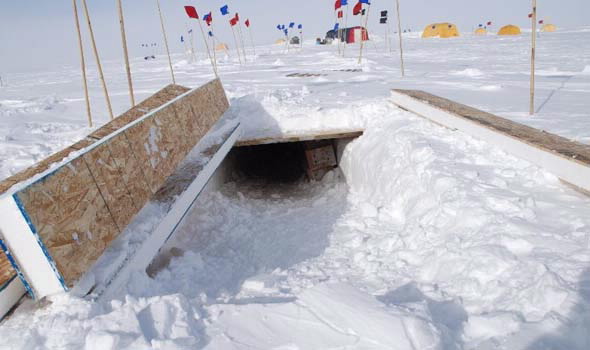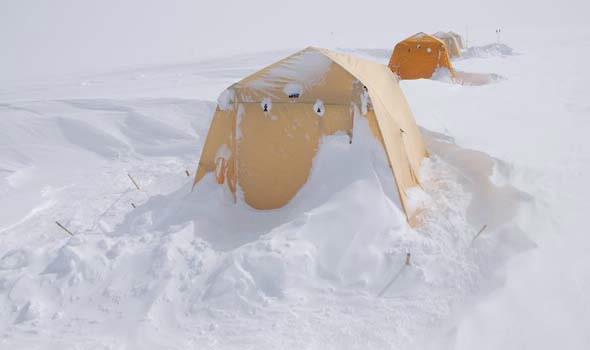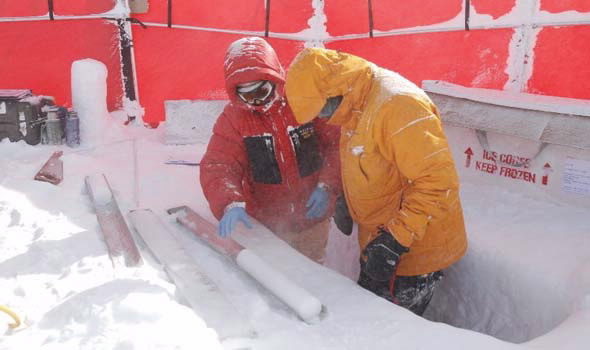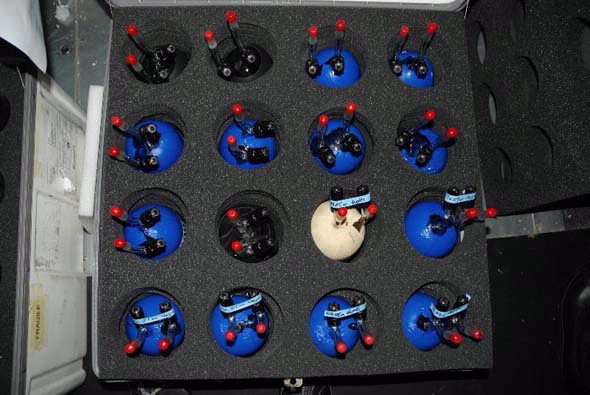 |
| The entrance to the ice cave where the ice cores are stored |
Highlights from week 3
Week 3 blogs:
- Thursday, 16th May: Technical problems hamper the drilling
- Friday, 17th May: 26m below the surface and counting
- Saturday, 18th May: No rest from the drifting snow
- Sunday, 19th May: Almost at 50m below the surface
- Monday, 20th May: 60m below the surface and counting
- Tuesday, 21st May: 65m depth finally struck!
- Wednesday, 22nd May: An explanation of how to capture firn air
Useful links:
- Photos from Greenland
- Blog from Rochester Laboratory: http://rochestericelab.wordpress.com/
- Real time webcam from Summit Camp in Greenland
- Visit our special micro site for more information on the expedition
- Read the week 1 blog
- Read the week 2 blog
- Read the week 4 blog
Thursday, 16th May: Technical problems hamper the drilling
This was a nuisance as the RGD system needs to attain a stable temperature to work and we were delayed a by a couple of hours as it settled down. By mid-morning we were ready to go and we drilled another 5 m to the next firn air sampling level. Now we had 10 m of firn core and the second ice core box was filled and moved into the ice cave. There were a lot of flasks to be filled at this level and this took about 3 hours, during which time we had lunch.
We got ourselves ready to continue, but found the winch motor assembly had frozen solid and we couldn’t use it to lift the bladder out of the hole. We finally raised it by hand and took the wind assembly ad control box inside to warm up and dry off.
 |
| Dr Andrew Smith's bedroom in Greenland. The photo illustrates how the conditions can change over a few hours. |
Friday, 17th May: 26m below the surface and counting
We missed last Saturday because we were so late deploying camp and we have decided to keep drilling tomorrow. As we will be drilling I will be staying in camp to log the core and it looks like I’ll be staying put until we reach the lock-in zone at about 65 m; below this level Christo will be taking the firn core and will take over logging. At this stage, Ben, Lindsay and Christo will be making the trip to Summit. The rest of us are going to start drilling at 06:00. I’d better get to bed!
Saturday, 18th May: No rest from the drifting snow
Drilling from 25 to 29 m went fairly smoothly but there was a lot of trouble retrieving the last metre before the next firn air sampling level. Once Lou put a stronger core dog spring on the drill head the last core was retrieved: a monster 1.5 m section. In the meantime, the weather worsened and was perhaps as miserable as we have had so far; very difficult conditions for coring and logging. There were also issues with the drill sheave and electronics and it was decided to wait for a lull in the weather to attend to these matters. No lull came! Indeed the wind is absolutely screaming outside. One nice side effect of this is the music it makes in the Science Lab. There is a pipe leading from the main distribution panel to the roof and the wind makes tones and overtones as it blows across it. Have a listen to ‘The Sound of the Science Lab.3ga’.
It is now 20:30 and we have had dinner. The storm continues unabated, yet there is talk of starting at 05:00 tomorrow. Somehow I just can’t see it. I am taking my warm, dry sleeping bag and a shovel to my tent. Goodnight!
 |
| The team logging ice cores |
Sunday, 19th May: Almost at 50m below the surface
After that it was smooth and we finished 10 m by lunchtime, having reached 40 m, the next firn air sampling level. With the better conditions, Christo, Ben and Lindsay left for Summit Station, so there were only the six of us working today.
After lunch we drilled another 5m to the next firn air sampling level and as I write at 17:45 that is nearly finished. Ice core box #5 has been moved into the ice cave. We plan to drill a further 5 m to 50 m depth and sample again tonight. I need to get some hot chocolate and carbohydrate into me quickly!
When we reach ~ 65 m Christo takes the rest of this core and also takes over the logging, then I’m off to enjoy the high life at Summit Station: sending you the next Greenland dispatch and photographs, a shower, washing my clothes and Sarah’s cooking. Shame there isn’t a bar!
 |
| A photo of Lindsay and Jon's ice core pit samples. |
Monday, 20th May: 60m below the surface and counting
Since I had finished my ice core logging by the middle of the day I offered to cook. Tonight we had beef rendang and basmati rice, thanks to the new supplies brought in by the Station visitors yesterday. It seemed to go down well!
 |
| Vas and a blizz trail |
Tuesday, 21st May: 65m depth finally struck!
We started drilling at 07:30 again this morning under perfect conditions; indeed, it was possible to see the Science Operations Barn and the Big House in the distance when the fog lifted. However, the drilling did not go well and we struggled to get the next 5 m of core to the next firn air sampling level at 65 m depth. We finally made it at about 12:30.
Now Christo takes over the ice core logging as we near the lock-in zone as he and Jon will be taking that ice to Oregon State University for analysis. Between the ‘lock in zone’ and the ‘close off depth’ (~ 85 m) the firn undergoes the transition to ice and then the air is locked in bubbles in the ice and so moves downward with the ice.
Good fun! We will stay for dinner and if the wind doesn’t pick up too much and blow from the North as threatened we will return to the camp this evening.
 |
| Air flasks used by Dr Andrew Smith and the team to capture firn air |
Wednesday, 22nd May: An explanation of how to capture firn air
Another good day…. the winds of the last week are becoming a distant memory. While the rest of core # 1 is drilled and Christo is logging the core I have more time on my hands.
Today I wrote a description of how a electro-mechanical ice core drill works; see below.
I also learnt how the firn air sampling equipment works, something I hadn’t had time to do until now. It is a complex system, and I am quite happy to let Vas and his team operate it! When we drill to a particular depth, the drill is removed and the bladder is inserted.
This is easy to say but not so easy to accomplish. At least four people are needed.
The first task is to move the heavy electric winch into position over the hole, putting a piece of wood over the hole to support one of the tripod legs.
Next, the bladder is carefully lifted from the trench it was placed in to keep it cold and out of the sun. Two or three people manhandle the 5 m long, 1/8” thick latex bladder towards the hole while others help pay out the tubing which was carefully laid over the snow and staked with flags.
At the hole, the end of the bladder is inserted and carefully lowered until it can be attached to the winch cable with a prusik knot and a clamp; this is done every 10 m as the bladder is lowered, until it reaches the bottom of the hole.
Once down, the hole is covered. It is critical not to drop anything down the hole: to do so would likely mean the end of drilling, spoiling the entire experiment. There are three tubes connected to the bladder: one to inflate it, so sealing the hole, another called the ‘waste line’ that draws air up from immediately below the bladder, and then the ‘sample line’ that draws air up from below a baffle and the hole bottom.
The waste line is connected to a pump that has a higher pumping rate than the sample line; the idea is that any air that passes the bladder from the hole above or any outgassing from the bladder will preferentially go up the waste line, so the sample line only collects air from a narrow horizontal layer of the firn. The bladder is inflated from the waste line. The LGR instrument which monitors CO2 and CH4 and the RGD instrument that monitors CO (and H) allow the operator to confirm that this is the case.
Before, during and after each run an air standard is also run through the entire system to check on system integrity and instrument calibration.
This is ‘modern air’ from Niwot Ridge, containing 392.4 ppm CO2 + 1851.91 ppb CH4 + 99.2 ppb CO and these gases contain radiocarbon, 14C, in modern concentrations.
At the start, middle and end of the entire sampling scheme ‘blank air’, a synthetic air mix that contains CO2 (~407 ppm) and CH4 (1925 ppb) that are depleted in radiocarbon, 14C, is also run through the system. Small samples are taken as a check on the stable isotopes of CO2 and CH4 and for non-methane hydrocarbons (NMHC). A very large sample taken in the middle is used as a check on the ‘procedural blank’ of the system, i.e. to see how much 14C is being added to each gas by the entire sampling system.
There is a third high pressure cylinder of ‘zero air’ air that has been scrubbed of CO, CO2 and CH4. This runs continuously through the RGD instrument. But what is this firn air to be used for? The answer is for many different purposes and by many different laboratories.
Have a look at the ‘Science’ section below for an overview. This evening Wednesday, 22nd I had an engagement at 22:30. As I needed privacy and it was about -26 °C outside I set up a 2 kVA generator in the snow and ran a power cable to a heater inside the large Antarctic Oven storage tent.
At the right time I called Caringbah High School in Sydney, Australia, by Iridium satellite phone when it was 10:30 on Thursday 23rd their time (we are exactly 12 hours different) to answer questions they had about the science we were doing and the experience of working in the Arctic.
There were some excellent questions, however there is one I will have to research further: is there lighting at Summit and if so, what happens when it strikes the snow?


